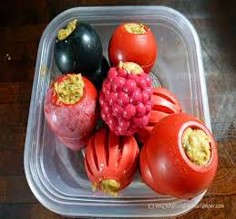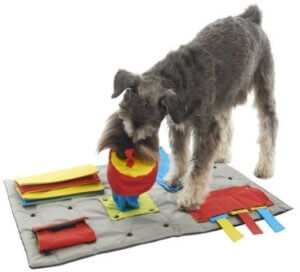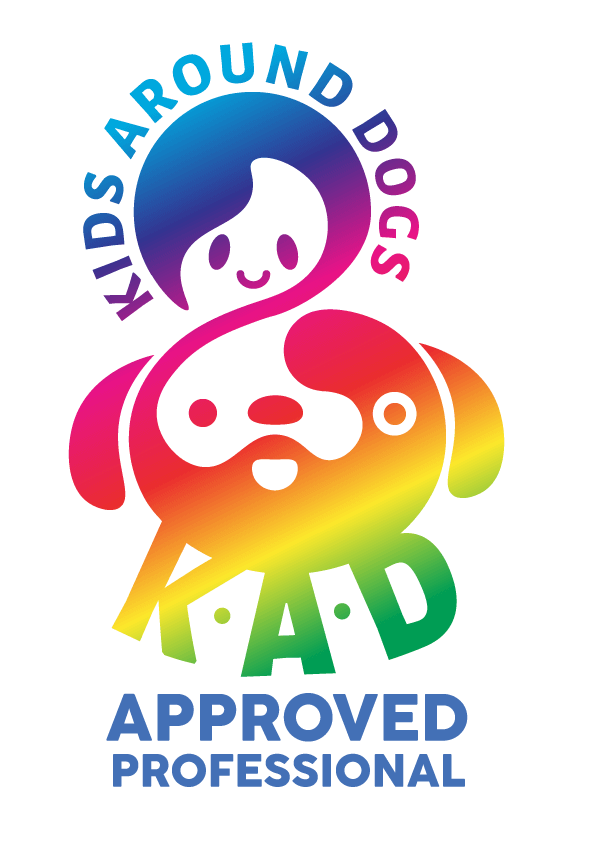While many of us are in lockdown, this presents a challenge for owners of energetic young dogs and certain breeds that typically require more exercise than others. Research suggests that reduced physical and mental stimulation is associated with increased dog anxiety (Menor-Campos et al., 2011), and this can lead to undesirable behaviours such excessive vocalisation, jumping up and chewing. With the change of routine, the prolonged and concentrated time families are spending together, along with the restrictions on movement (limited to one form of exercise a day such as a walk), frustrations might be directed at the dog and or stress-related changes in the dog’s behaviour may start to appear. To avoid this, we can positively direct our dog’s energies through some simple hacks…
1. Chase and tug


For dogs that enjoy the thrill of the chase, are high energy and or enjoy a good game of tug then I recommend chase and tug toys. Many of my clients know I am a fan of tail teasers, rabbit bungees and similar – think giant cat rod toys but for dogs! These toys allow for quick bursts of high cardio exercise in the comfort of your home or garden. It’s lazy dog training at its best as all you need to do is stand there and move the teaser around to mimic the movement of prey and your dog will do the rest. You can clock up your dog miles by passing it from one hand to the next, creating wide semi- and full-circles as your dog chases after the toy. Just be mindful to have frequent pauses to allow your dog to catch his breath and be aware of the substrate you’re doing this on as we want to avoid any slips or sharp turns that could hurt your dog.
These toys also enable practice for impulse control such as the ‘drop’ and ‘leave it’. Such increased exercise will lower the dog’s energy and any stress by increasing β-endorphin release (Radosevich et al., 1989; Affenzeller et al., 2017). Check out the chase toys at Tug-E-Nuff and be sure to type in HGPETS into the coupon code to grab yourself some money off!
2. Sniff ‘n’ search

There are lots of scent games to be played. One easy to play game that can bust a few of your dog’s neurons is What Pot’s It Under? Wash out three large yoghurt-type pots and have a handful of treats. Rub all three pots with the treat. (If you don’t your dog will simply follow his super-sensitive nose to the correct pot). Sit opposite your dog and ask him to ‘Wait’. If your dog hasn’t learnt a wait behaviour, then ask someone to gently hold onto your dog’s collar or shoulders to avoid him rushing over to the pots. Show your dog the treat in your hand. Put it under one of the pots and repeat your ‘wait’ request (if he knows this). Mix the pots around as your dog watches. Stop moving the pots and say, ‘Get it.’ Your dog will topple all the pots trying to find the magic one. For more on easy scent games to play, click here.
3. Lick and chew-tastic



Enrichment toys promote serotonin release (DeNapoli et al., 2000) – in other words ‘happy hormones’ – so this is a useful way in which we can modify behaviour. For example, licking and chewing onto food puzzle toys enables reinforcement of incompatible behaviours to barking (Schipper et al., 2008) or chewing inappropriate items such as furniture.
There is a plethora of food puzzle toys to choose, however, some of my all-time favourites include: a fully stuffed and layered classic Kong, chomp bone and lickkie mat – all pictured above. Be sure that when you are using food puzzle toys, especially the Kong, these are well-packed with various foods to maximise that chewing and licking time which promotes restful behaviour. This is especially important for owners of young puppies to nurture all that biting onto desired items, and for dogs that like to bark when owners are trying to hold conference calls!
4. Linguistic challenge
Teaching your dog to recognise the names which are associated with objects and toys is a great way to test their linguistic understanding, and promote periods of focus, impulse control and inference which can boost brain power (Marshall-Pescini et al., 2008). A great example of inferential learning in dogs was demonstrated by the late and great Chaser – a Border Collie owned by Dr John Pilley who showed rapid retention of new words amounting to the comprehension of 1022 labels, including object-related and action words (Kaminski and Marshall-Pescini, 2014). Click here to see Chaser in action.

There are various ways to teach your dog the names of his toys, but one route is to simply present a toy he already knows, such as a favoured ball or Kong and ask him to ‘Get it’. Praise and reward your dog for bringing it to you. Continue to repeat this over 2-3 sessions or until you are sure your dog understands the name of that toy. Then introduce another item that he is less familiar with together with that favoured toy. This could be an old kitchen spatula, plastic pot or slipper – anything that is a different shape, size and texture to differentiate it from the original toy. Then ask your dog to ‘get’ the favoured toy. Praise and reward when he gets this right. Then repeat this process with a new item such as a rope toy. Having taught the name of the second toy to your dog, progress onto laying the second toy out in front of your dog along with the original toy plus another item (e.g. slipper) approx. one metre away so you dog can clearly see all the items. This means you now have two toys which you have attached labels to and a third item which your dog does not yet know the name of. Now practice cueing your dog for the toys in different order. For example, ‘Kong’, ‘Rope’, ‘Rope’, Kong, ‘Rope, ‘Kong’. When you are sure your dog knows the names for both toys, add in a third toy – and work on teaching your dog the name of that one by following the process all over again. Praise and reward your dog each time he gets it right. Eventually, you can build up your dog’s vocabulary skills and create your very own Canine-Einstein! Avoid long and drawn out training sessions with this one – keep to 5 minutes to ensure you’re both having fun.
5. Brain busters


Data indicates that dogs enjoy problem-solving (McGowan et al., 2013) and the pet accessories market has tapped into the principles of trial and error learning. For example, Nina Ottosson has produced a variety of puzzle-food toys for dogs and cats, designed to trigger the animal’s seeking system (Panksepp, 2005). Check out games including the Dog Smart, Dog Worker and DogTornado.
Less expensive alternatives available online include: snuffle and activity mats. Alternatively, you can work your imagination and create your own. Read Playing With Your Dog for some ideas on this.
Duke University has also built on the increased interest in canine cognition and training through positive reinforcement with its Dognition website. This membership based site includes 20 interactive games enabling owners to ‘test’ their dog’s intelligence, and produces an in-depth game analysis of your dog’s performance, giving you great insight into your dog’s character and abilities.
Another alternative is to sign up to a live training class or 1-1 training session with a trainer in your area. This can help to keep your dog on-track with any training needs, gives you a chance to enjoy time together learning new things and supports local businesses. Do get in touch if you’re interested in our online classes coming soon, and our 1-1 virtual training sessions, available now.
Healthy mind and body

If your dog’s typical exercise regime has greatly changed due to the lockdown, then be mindful of his or her daily calorie intake and protein levels to ensure your dog’s diet is well-balanced and adjusted to their new daily activity level. For example, some research suggests changing a dog’s diet from high protein to a moderate-low protein diet with increased carbohydrate stimulates insulin secretion, enabling tryptophan (serotonin precursor) to amass (Lindley, 2009). This may help reduce high arousal behaviours, such as barking, pulling on the lead and jumping up. If you are going to alter your dog’s diet, do change this over slowly to avoid any stomach upset.
Finally, use this unique time to give yourself permission to be creative in how you can keep yourselves and your four-legged friends mentally and physically fit and well. Why not share your ideas with us on our Facebook page.
Take care and stay well.
References
Affenzeller, N., Palme, R., and Zulch, H. (2017) Playful activity post-learning improves training performance in Labrador Retriever dogs (Canis lupus familiaris). Physiol Behav. 1 pp.168:62-73. doi: 10.1016/j.physbeh.2016.10.014.
DeNapoli, J.S., Dodman, N.H., Shuster, L., Rand, W.M., and Gross, K.L. (2000) ‘Effect of dietary protein content and tryptophan supplementation on dominance aggression, territorial aggression, and hyperactivity in dogs.’ Scientific Reports. 217(4) pp.504-508.
Lindley, S. (2009) ‘Separation-related problems in dogs and cats.’ D.F. Horwitz, D.F., and Mills, D.S. (Eds.) BSAVA Manual of Canine and Feline Behavioural Medicine. Quedgeley: British Small Animal Veterinary Association pp.146-158
Menor-Campos, D.J., Molleda-Carbonell, J.M., and López-Rodríguez, R. (2011) Effects of exercise and human contact on animal welfare in a dog shelter. Veterinary Record. 169, p.388.
McGowan, R.T.S., Rehn, T., Norling, Y. and Keeling, L.J. (2013) ‘Positive affect and learning: Exploring the “Eureka Effect” in dogs.’ Animal Cognition. 17(3) pp.577–587.
Marshall-Pescini, S., Valsecchi, P., Petak, I., and Prato-Previde, E. (2008) ‘Does training make you smarter? The effects of training on dogs’ performance (Canis familiaris) in a problem solving task.’ Behavioural Processes 78(3) pp.449-54. DOI: 10.1016/j.beproc.2008.02.022.
Panksepp, J. (2005) ‘Affective consciousness: Core emotional feelings in animals and humans.’ Consciousness and Cognition 14(1) pp.30–80.
Radosevich, P.M., Nash, J.A., Lacy, B.D., O’Donovan, C., Williams, P.E., and Abumrad, N.N. (1989) Brain Research. 498(1) pp.89-98
Learn more about our classes

Get Hanne's Book
Playing With Your Dog will help any dog owner work out the games that are best suited for their pet to play throughout his life, from puppyhood to old age. The book also shares some tricks for all ages, group activities, and recommended toys that dogs will enjoy.

























